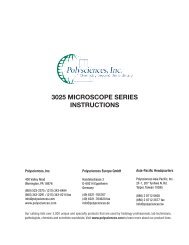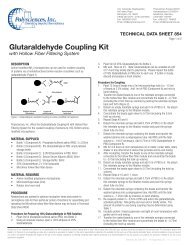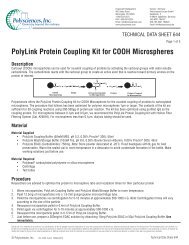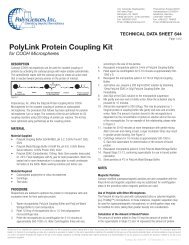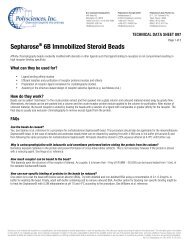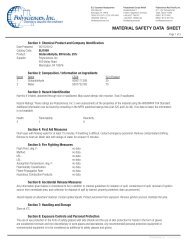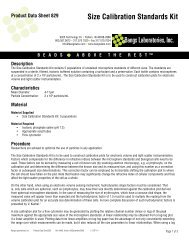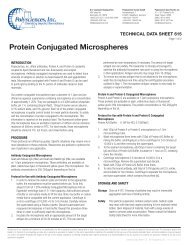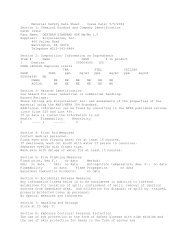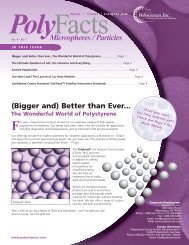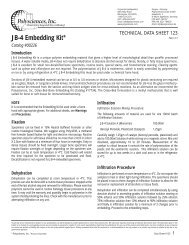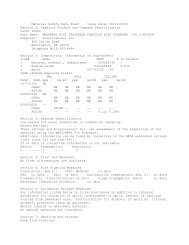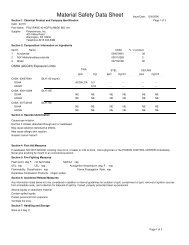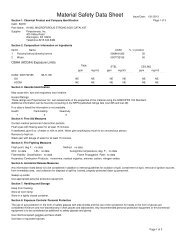Data Sheet #238G - Polysciences, Inc.
Data Sheet #238G - Polysciences, Inc.
Data Sheet #238G - Polysciences, Inc.
Create successful ePaper yourself
Turn your PDF publications into a flip-book with our unique Google optimized e-Paper software.
U.S. Corporate Headquarters<br />
400 Valley Rd.<br />
Warrington, PA 18976<br />
1(800) 523-2575 / (215) 343-6484<br />
1(800)343-3291 fax<br />
info@polysciences.com<br />
<strong>Polysciences</strong> Europe GmbH<br />
Handelsstrasse 3<br />
D-69214 Eppelheim, Germany<br />
+(49) 6221-765767<br />
+(49) 6221-764620 fax<br />
info@polysciences.de<br />
<strong>Polysciences</strong> Asia-Pacific, <strong>Inc</strong>.<br />
2F-1, 207 DunHua N. Rd.<br />
Taipei, Taiwan 10595<br />
(886) 2 8712 0600<br />
(886) 2 8712 2677 fax<br />
info@polysciences.tw<br />
Protocol for Glutaraldehyde Kit<br />
for Use with Amino and Blue Dyed Beads<br />
TECHNICAL DATA SHEET 238G<br />
Page 1 of 2<br />
INTRODUCTION<br />
<strong>Polysciences</strong> offers the Glutaraldehyde Kit for covalently coupling proteins<br />
to amino-functionalized polystyrene beads and blue dyed polystyrene beads.<br />
The contents of the kit are sufficient for at least fifty-five 0.5ml samples<br />
(2.5% solids) of amino beads or blue dyed beads. To use the kit for larger<br />
samples, increase all volumes in a proportional manner. This procedure<br />
is recommended for microspheres 0.5µm or larger. If using microspheres<br />
smaller than 0.5µm, please use our Glutaraldehyde Kit with Hollow Fiber<br />
Filtering System (Cat. #23964).<br />
MATERIAL<br />
Material Supplied<br />
• Bottle 1 (Component A): Phosphate buffered saline (PBS), 3 x<br />
225ml<br />
• Bottle 2 (Component B): 8% Glutaraldehyde in PBS, empty<br />
labeled storage bottle<br />
• Bottle 3 (Component C): 0.2 M Ethanolamine in PBS, 60ml<br />
• Bottle 4 (Component D): Bovine Serum Albumin (BSA), 60ml<br />
• Bottle 5 (Component E): Storage Buffer, 60ml<br />
• 25% Glutaraldehyde, 2 x 10ml<br />
PROCEDURE<br />
Researchers are advised to optimize the use of particles in any application,<br />
as procedures designed by other manufacturers may not be ideal.<br />
Procedure to Preparing 8% Glutaraldehyde in PBS Solution<br />
1. Pipette 10ml of phosphate buffered saline (PBS) into Bottle 2.<br />
2. Using ampoule cracker, open 10ml ampoule of 25% Glutaraldehyde.<br />
3. Pipette 5ml of 25% Glutaraldehyde into Bottle 2.<br />
4. Mix well. Store at 4˚C. Note: Glutaraldehyde can be unstable at a pH<br />
of 7.4 and may slowly start to polymerize. Please inspect the 8%<br />
Glutaraldehyde, PBS solution prior to each use. If turbid or cloudy,<br />
discard and prepare a fresh solution.<br />
Procedure for Coupling<br />
1. Place 0.5ml of a 2.5% aqueous suspension of beads in an Eppendorf<br />
centrifuge tube (1.5ml - 1.9ml capacity).<br />
2. Add enough PBS (Component A) to fill the tube and cap tightly.<br />
3. Centrifuge for 6 minutes in a microcentrifuge.<br />
4. Remove supernatant carefully using a Pasteur pipette. Discard<br />
supernatant.<br />
5. Resuspend pellet in PBS as follows:<br />
a. Fill tube halfway and cap tightly.<br />
b. Vortex until pellet is completely dispersed.<br />
c. Fill tube close to capacity and cap. Note: When term “resuspend<br />
pellet” is used, refer to this step (Step 5).<br />
6. Centrifuge for 6 minutes and discard supernatant.<br />
7. Repeat Steps 5 and 6, once.<br />
8. Resuspend pellet in 0.5ml of 8% glutaraldehyde in PBS (Component<br />
B).<br />
9. Mix for 4-6 hours at room temperature on a rocker table, rotary shaker<br />
or any other kind of shaker that provides end-to-end mixing.<br />
10. Centrifuge for 6 minutes and discard supernatant.<br />
11. Repeat Steps 5 and 6, twice.<br />
12. Resuspend pellet in 1ml of PBS.<br />
13. Add 200-400µg of protein to be coupled.<br />
14. Leave overnight at room temperature with gentle end-to-end mixing.<br />
15. Centrifuge for 10 minutes. Using a Pasteur pipette, transfer the<br />
supernatant completely into a small graduated cylinder or graduated<br />
centrifuge tube. Note the volume of the supernatant and save it<br />
for protein determination. Note: If protein determination is done<br />
spectrophotometrically, make sure that the supernatant is completely<br />
free of turbidity. This can be achieved by centrifuging supernatant for<br />
an additional 10 minutes. The amount of protein added in Step 13<br />
minus the amount in the supernatant represents the amount bound to<br />
the microparticles.<br />
16. Resuspend pellet in 1ml of 0.2 M ethanolamine (Component C) and<br />
mix gently for 30 minutes at room temperature. This step serves to<br />
block unreacted sites on the microparticles.<br />
17. Centrifuge for 6 minutes and discard supernatant.<br />
18. Resuspend pellet in 1ml of BSA solution (Component D) and mix gently<br />
for 30 minutes at room temperature. The BSA will block any remaining<br />
nonspecific protein binding sites.<br />
19. Centrifuge for 6 minutes and discard supernatant.<br />
20. Resuspend pellet in 0.5ml to 1.0ml of storage buffer (Component E).<br />
STORAGE AND SAFETY<br />
Storage Store the components of the kit, coupled microparticles, 25%<br />
Glutaraldehyde Ampoules and Bottle 2 at 4˚C. Freezing may result<br />
in irreversible aggregation and loss of binding activity.<br />
Safety<br />
Glutaraldehyde is harmful if absorbed through the skin. Avoid<br />
contact with eyes, skin or clothing. Avoid breathing vapors. Use<br />
only with adequate ventilation. Wear protective gloves and safety<br />
goggles. In case of contact, immediately flush eyes or skin with<br />
plenty of water for at least 15 minutes. Remove contaminated<br />
clothing and shoes. Call a physician. Wash contaminated clothing<br />
and shoes before wearing again.<br />
Should any of our materials fail to perform to our specifications, we will be pleased to provide replacements or return the purchase price. We solicit your inquiries concerning all needs for life sciences work. The information given in this bulletin<br />
is to the best of our knowledge accurate, but no warranty is expressed or implied. It is the user’s responsibility to determine the suitability for their own use of the products described herein, and since conditions of use are beyond our control,<br />
we disclaim all liability with respect to the use of any material supplied by us. Nothing contained herein shall be construed as a recommendation to use any product or to practice any process in violation of any law or any government regulation.<br />
© 2013 <strong>Polysciences</strong>, <strong>Inc</strong>. Rev. #4 05.16.2013
TECHNICAL DATA SHEET 238G<br />
Page 2 of 2<br />
Components D and E contain sodium azide at 0.05% and 0.1%<br />
concentrations respectively. Sodium azide is highly toxic. Avoid<br />
contact with eyes and skin. Do not pour contents down metal<br />
drains. Sodium azide may react with lead and copper plumbing to<br />
form explosive metal azides. Upon disposal of material, flush with<br />
a large volume of water to prevent azide accumulation. Please<br />
consult the Material Safety <strong>Data</strong> <strong>Sheet</strong> for more information.<br />
These products are for research use only and are not intended for<br />
use in humans or for in vitro diagnostic use.<br />
ORDERING INFORMATION<br />
Cat. # Description Size<br />
19540-1<br />
Glutaraldehyde Kit for Amine and Blue<br />
Dyed Microspheres<br />
1 kit<br />
23964-1<br />
Glutaraldehyde Kit with Hollow Fiber<br />
Filtering System<br />
1 kit<br />
RELATED PRODUCTS<br />
Cat. # Description Size<br />
16586-5<br />
15699-5<br />
07763-5<br />
17144-5<br />
17010-5<br />
17145-5<br />
19118-5<br />
18879-2<br />
18879-5<br />
Polybead ® Amino Microspheres, 0.10µm<br />
Polybead ® Amino Microspheres, 0.20µm<br />
Polybead ® Amino Microspheres, 0.50µm<br />
Polybead ® Amino Microspheres, 0.75µm<br />
Polybead ® Amino Microspheres, 1.00µm<br />
Polybead ® Amino Microspheres, 3.00µm<br />
Polybead ® Amino Microspheres, 6.00µm<br />
Superparamagnetic Amino Microspheres,<br />
1-2µm<br />
Superparamagnetic Amino Microspheres,<br />
1-2µm<br />
5ml<br />
5ml<br />
5ml<br />
5ml<br />
5ml<br />
5ml<br />
5ml<br />
2ml<br />
5ml<br />
TO ORDER<br />
In The U.S. Call: 1(800) 523-2575 • (215) 343-6484<br />
In The U.S. Fax: 1(800) 343-3291 • (215) 343-0214<br />
In Germany Call: +(49) 6221-765767<br />
In Germany Fax: +(49) 6221-764620<br />
In Asia Call: (886) 2 8712 0600<br />
In Asia Fax: (886) 2 8712 2677<br />
Order online anytime at www.polysciences.com<br />
Should any of our materials fail to perform to our specifications, we will be pleased to provide replacements or return the purchase price. We solicit your inquiries concerning all needs for life sciences work. The information given in this bulletin<br />
is to the best of our knowledge accurate, but no warranty is expressed or implied. It is the user’s responsibility to determine the suitability for their own use of the products described herein, and since conditions of use are beyond our control,<br />
we disclaim all liability with respect to the use of any material supplied by us. Nothing contained herein shall be construed as a recommendation to use any product or to practice any process in violation of any law or any government regulation.<br />
© 2013 <strong>Polysciences</strong>, <strong>Inc</strong>. Rev. #4 05.16.2013



